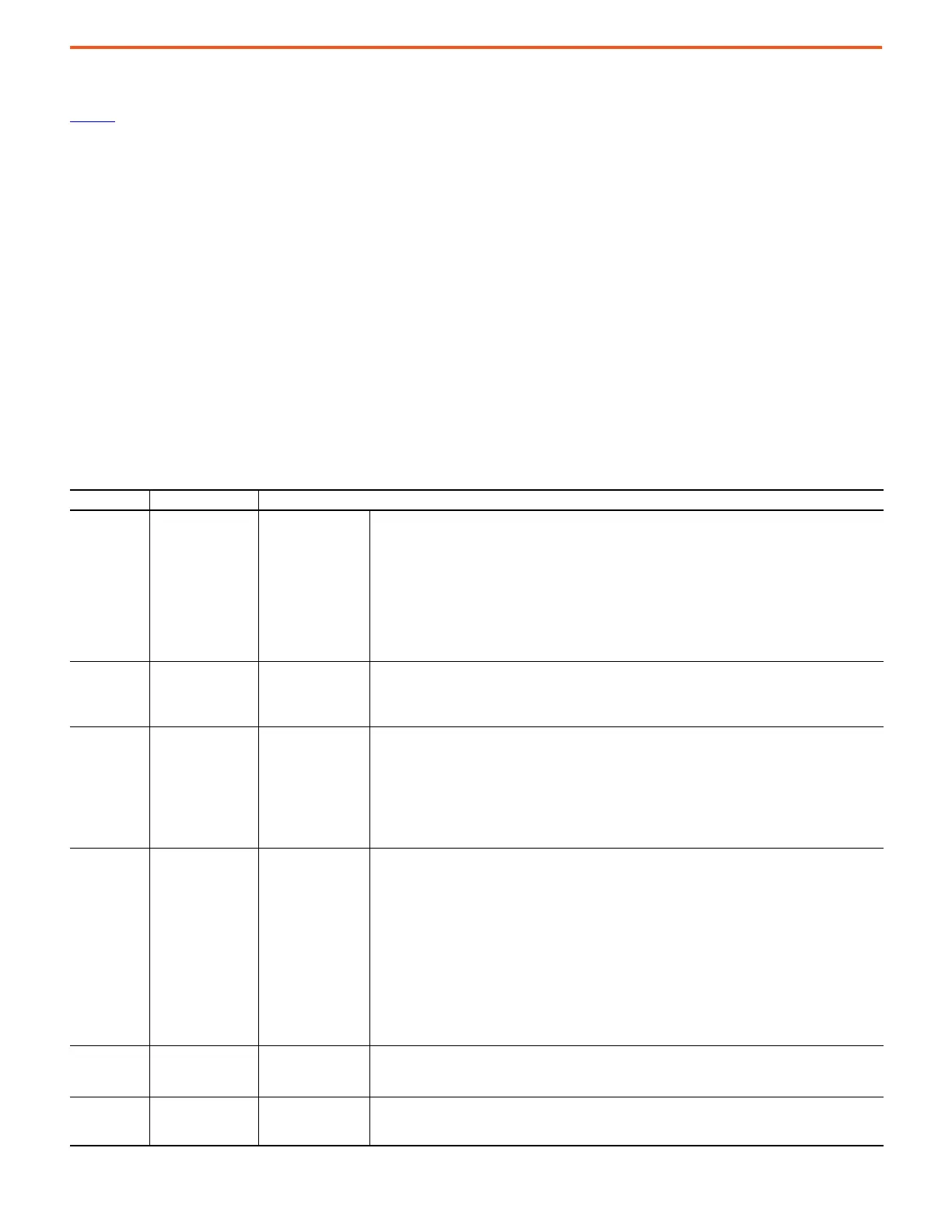88 Rockwell Automation Publication 750-AT006D-EN-P - January 2022
Chapter 6 Active Front End Tuning
Tuning
Table 31 summarizes the parameters that are required to configure the bus observer.
• BusObsBw: It is recommended to set the B
W
of the bus observer to four times the B
W
of the bus regulator. This is to maintain a 4:1 loop
spacing ratio between the bus observer B
W
and the bus regulator B
W
, which avoids avoid any interaction between the DC bus regulator
and the DC bus observer.
– The B
W
and the damping of the bus observer function can be adjusted, if needed, by configuring 13:306 [BusObs Sys Bw] and
13:307 [BusObsSysDamping].
– You can set the proportional and integral gains of the bus observer controller directly through13:322 [u BusObsKp] and
13:324 [u Bus Obs Ki].
• BusObsMode: the bus observer mode determines the configuration of the feedback loop of the system. If the system is configured
such that the measured DC bus voltage is used as a feedback signal for the voltage control loop, the system can exhibit superior
dynamic performance and disturbance rejection. However, in that case, it is recommended that you properly enter the external
capacitance C
ext
in the user parameters.
– If the system is configured such that the bus voltage estimated by the bus observer is used instead, it is not required to enter the
value of the external capacitance if the external capacitance is less than four times the rated capacitance of the drive. The
system still exhibits excellent dynamic performance and disturbance rejection.
– The bus observer mode can be configured using 13:320 [BusObs Config].
Table 31 - Bus Observer Tuning Parameter Settings
Parameter No. Parameter Name Description
13:305 [BusObs C/U Sel]
Bus Observer Calc/
User Entered Select
Enter a value to select whether calculated values or user-entered values are applied to the DC bus voltage
regulator and Bus Observer.
Calculated values are determined by equations based on the values in 13:306 [BusObs Sys BW] and
13:307 [BusObsSysDamping], as well as the rating of the line-side converter. Parameter values are as
follows.
• Calculated (0) – selects the calculated 'c' values.
• User Entered (1) – selects the user-entered 'u' values.
• LoadCalcData (2) – copies the calculated 'c' values into the parameter for the user-entered 'u' values. This
is useful for starting with the calculated values and then adjusting them.
After performing the copy, this switch will revert to position User Entered (1).
13:306 [BusObs Sys BW]
Bus Observer System
Bandwidth
Enter the system bandwidth of the Bus Observer in units of Hz.
• Used to generate calculated values of the voltage regulator and the Bus Observer gains.
• This value only affects the calculated regulator gains, which are used when parameter
13:305 [BusObs C/U Sel] is set to Calculated (0).
13:307 [BusObsSysDamping]
Bus Observer System
Damping
Enter the system damping factor for the Bus Observer and DC bus voltage regulator.
This automatically sets the damping for the voltage regulator and affects the calculated gains of the Bus
Observer and the voltage regulator.
• A default value of 1.0 generates a critically damping system that is suitable for most of the applications.
– Lowering the damping increases responsiveness but makes the response more oscillatory.
– Increasing the damping decreases responsiveness but makes the response smoother.
• This value only affects the calculated regulator gains, which are used when 13:300 [System C/U Sel] is
set to Calculated (0).
13:320 [BusObs Config]
Bus Observer
Configuration
Select the mode for the Bus Observer function. Parameter values are as follows.
• Disabled (0) – Bus Observer disabled.
• BusObs Only (1) – Bus Observer Only mode.
– In this mode, the Bus Observer compensates for the unknown capacitance and it only decouples that
load. The voltage control loop uses the actual measured DC bus voltage as the feedback signal.
– The DC bus voltage regulator B
W
and damping are set based on 13:306 [BusObs Sys BW] and
13:307 [BusObsSysDamping].
• BusObsVltEst (2) – Bus Observer with voltage estimate mode.
– In this mode, the Bus Observer compensates for unknown capacitance to decouple that load.
– The voltage control uses the estimated DC bus voltage as the feedback signal.
– 13:52 [Ext Bus Cap] is not used in this mode.
– The DC bus voltage regulator B
W
and damping are set based on 13:306 [BusObs Sys BW] and
13:307 [BusObsSysDamping].
13:321 [c BusObs Kp]
Bus Observer
Proportional Gain -
Calc
Displays the calculated value of the Bus Observer proportional gain.
• Used when 13:305 [BusObs C/U Sel] is set to Calculated (0).
• Calculated based on the settings in 13:306 [BusObs Sys BW] and 13:307 [BusObsSysDamping].
13:322 [u BusObs Kp]
Bus Observer
Proportional Gain -
User
Enter the Bus Observer proportional gain in units of Hz.
• Used when 13:305 [BusObs C/U Sel] is set to User Entered (1).

